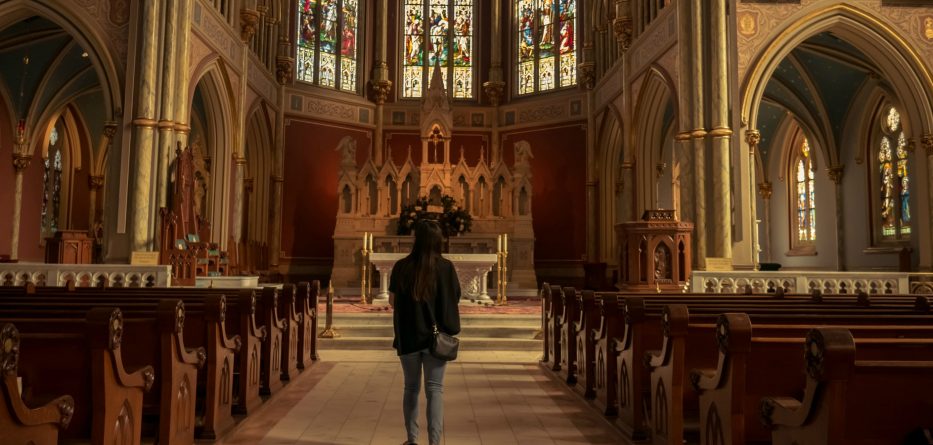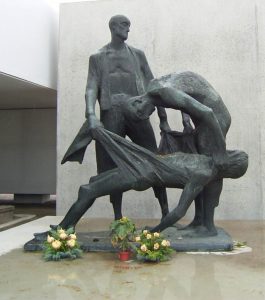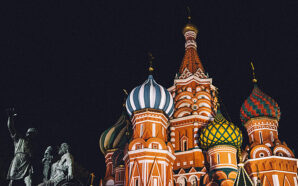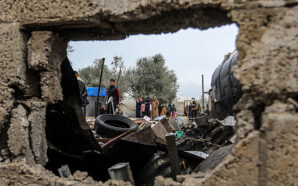Going and Staying on Pilgrimage
In this article we think of pilgrimage as a journey, but an interior journey of transformation. Pilgrimage is practised in the religions of the Book, Judaism, Christianity and Islam and in Buddhism, Hinduism and Sikhism. It is practised by people without a declared spiritual purpose. Individuals and groups seek to connect with a cultural identity, to memorialise victims of a past atrocity or catastrophe, to create new bonds with fellow pilgrims.
Experiencing Place
A school group of teenagers visit Berlin and the memorial to the murdered Jews of Europe and then go onto a concentration camp, Sachsenhausen, a little north of Berlin. They arrive talking excitedly. They enter the space, the guide begins to speak and silence overtakes the chatter of the teenagers. They stare at the images. Some of them don’t know what to do: they fiddle with their clothing, even remove their baseball caps; go from one foot to the other. Something is happening to them; they don’t quite know what and even on the return journey, they cannot articulate it.
But later in the debrief back at school, the profound experience shows its effects. They have greater awareness of a terrible force that was unleashed; the injustice of discrimination against a particular group is raw and many of them feel the contrast between humanity and inhumanity in a new way, but in way which makes them resolve that such a thing must not happen again and that they have a personal responsibility to ensure that it does not.
What Can we Learn?
The teenagers did not visit the shrine of a saint. No prayer was recited, no ritual enacted but the teenagers have been on a journey of transformation. Something similar could be said of the thousands of young Australians who visit Gallipoli to commemorate Anzac Day.
RELATED: The ancient ritual of pilgrimage
This scenario shows that scholars of pilgrimage, anthropologists, sociologists, as well as religious scholars have come to understand that the processes and experience of pilgrimage is transformative. Some speak of a secular pilgrimage but that is a difficult notion. If it means that the destination is not overtly religious, for example Mecca for the Hajj, Lourdes for Catholics, then yes, pilgrimage could be said to be secular. But pilgrimage is not about destination; it is about internal process.
Outward Actions Mirror Internal Change
A friend of mine walked the Camino some years ago. He was a fit 53 year-old at the time. He would not have considered himself particularly religious, at least in the sense of weekly Mass attendance. On the Camino, he didn’t use one of those travel companies which transport your luggage. He carried everything he needed. As he progressed and the days grew hotter and his feet blistered more and more, he began to leave behind the things he did not need. He had thought he needed them, but realised that he didn’t.
My friend finished his journey with one third of the stuff he had started with. Travelling in Europe and then back home in Australia, he slowly came to the realisation that he had shed more than the externals he was carrying. He had shed much of the internal baggage accumulated over the years. He described it as having a new sense of himself which, startlingly for him, included a new sense of the spiritual dimension of his being. On the Camino he found himself praying, not reciting prayers, but walking with God. He is still walking with God. Today he would he say he makes room for God to walk with him.
Pilgrimage as Processes for Transformation of Life
In the sense that pilgrimage has been illustrated here, as an internal transformation, it follows that one does not physically have to go anywhere in order to be on pilgrimage. Prisoners constitute one group who cannot travel on pilgrimage yet one group of inmates in the United States embarked on a pilgrimage based on the pilgrim-poet in Dante’s Divine Comedy. This communal exercise helped them to reflect on past decisions, connect with others on the same journey and change the patterns of behaviour which led to their incarceration.
Already we have seen that pilgrimage is not just an indulgence in self-absorption: it engenders a new sense of awareness, of responsibility and of commitment to the good of others and the good of the planet. Pilgrimage as an instrument of reconciliation is well-documented and one striking example is the Gaza Visioning Project, a visioning exercise focusing on pathways to peace and prosperity in the Middle East. Participants ‘stand in the future’, and look back to the present. Employing this technique, the role of pilgrimage as an avenue for the reconciliation of individuals, political factions, states, and religions may be explored.
Before and After
Pilgrimage and its effects are not magic. While the intention and motivation may not be clearly formed in the mind of the pilgrim before departing on pilgrimage, some openness to the experience of pilgrimage would seem to be necessary. That is why periods of spiritual preparation, such as that in which World Youth Day pilgrims engage is helpful. The fruits of pilgrimage are not usually instant. It requires some sustained reflection on return to appreciate the fruits and to integrate them into a way of living.
A word of comfort for those who, for whatever, cannot participate in physically going on pilgrimage. The concept of ‘armchair pilgrimage’ is yours. Remember St Jerome, who wrote in his thirteenth letter to St Paulinus, that “access to the courts of heaven is as easy from Britain as it is from Jerusalem.” God’s work is not hampered by our inability to travel! Taking a little time to read a spiritual or inspirational book, to review photos or journals of a transformative journey taken many years ago open will our hearts to God who wants to walk with us in love.
Our first article on The ancient ritual of pilgrimage can be found here.
Sr Vivienne Keely is co-editor with Ian McIntosh and E. Moore Quinn of Pilgrimage in Practice: Narration, Reclamation and Healing (CABI, United Kingdom: 2018).










